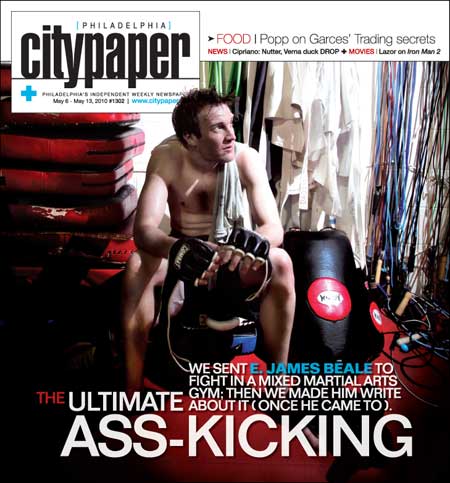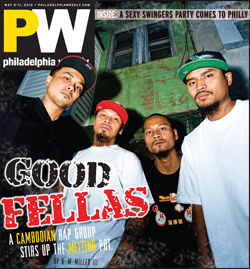 BY DAVE ALLEN Like time, news waits for no man. Keeping up with the funny papers has always been an all-day job, even in the pre-Internets era. These days, however, it’s a two-man job. That’s right, these days you need someone to do your reading for you, or risk falling hopelessly behind and, as a result, increasing your chances of dying lonely and somewhat bitter. That’s why every week PAPERBOY does your alt-weekly reading for you. We pore over those time-consuming cover stories and give you the takeaway, suss out the cover art, warn you off the ink-wasters and steer you towards the gooey center. Why? Because we love you!
BY DAVE ALLEN Like time, news waits for no man. Keeping up with the funny papers has always been an all-day job, even in the pre-Internets era. These days, however, it’s a two-man job. That’s right, these days you need someone to do your reading for you, or risk falling hopelessly behind and, as a result, increasing your chances of dying lonely and somewhat bitter. That’s why every week PAPERBOY does your alt-weekly reading for you. We pore over those time-consuming cover stories and give you the takeaway, suss out the cover art, warn you off the ink-wasters and steer you towards the gooey center. Why? Because we love you!
ON THE COVER
CP: E. James Beale got choked. No, not by someone who remembers his prediction of “Rays in 6” before the 2008 World Series. Dude immersed himself in the world of Mixed Martial Arts and emerged with a intriguing piece that starts out with an arresting chokehold of a lead and moves on to a concise rundown of MMA’s ever-tightening headlock on sports culture both in Philly and nationally.
MMA is no longer just for thugs on street corners and the most brutal outliers in traditional martial arts; it has spread across demographic  and social strata, and permeates a larger swath of American culture than your mother would probably imagine. And it is very much alive in Philly.
and social strata, and permeates a larger swath of American culture than your mother would probably imagine. And it is very much alive in Philly.
With dozens of schools, thousands of students and near-monthly fights, Philadelphia has become a hotbed for MMA: Tiger Schulmann’s Karate, longtime proprietor of strip-mall dojos, is now Tiger Schulmann’s MMA. Balance Studios has grown from zero gyms eight years ago to 32 as of April. Brad Daddis, who runs Daddis Fight Camps, has expanded his Philly studio twice and spread into Cherry Hill and Medford, N.J. And Brazilian Jiu-Jitsu United in Jenkintown has nearly tripled its students in the last five years — and that just touches on the bigger gyms. If you want to avoid major studios, you have options, as well: Former pro fighters like Travis Roesler run MMA training programs out of converted apartments, and even the 12th Street Gym offers an MMA class.
Gyms are popping up from Rittenhouse to Kensington to Jenkintown to Mount Airy, and they’re not just filled with the toughest guys the streets can find. Bankers, frat boys, construction workers, Ph.D.s, off-duty police officers, soccer moms, the guy selling you BlackBerrys, high school bullies and the nerds who want to avoid them are all showing up in your neighborhood gym, trying to choke each other out.
Before and after submitting to a titanic ass-whupping, Beale draws links to the city’s affinity for boxing and to a family of pummeling pioneers who helped MMA take root here. Nicely done. Further cred, earned in the service of full immersion: that’s the man himself on the cover, getting handled by fighters inside and, yes, yarfing into a toilet after an exhausting workout. Consider this my tap out.
PW: G.W. Miller digs up another fascinating story from the city’s Asian-American community: a group of Cambodian rappers creating music out of the struggles to arrive in the US and make a life here. He touches on the history of Southeast Asia and on the sounds that the AZI Fellas are producing, but much of the space necessarily focuses on the immigrant experience and the integration of Cambodians into an often-unforgiving urban environment.
 In a genre that reveres authenticity, it’s hard to argue that anyone could be more street than these guys—even though they’re Asian. And in a city that has unsuccessfully been dealing with tensions between Asian and African-American students in the public schools and elsewhere, the AZI Fellas may be the perfect bridge between the two cultures.
In a genre that reveres authenticity, it’s hard to argue that anyone could be more street than these guys—even though they’re Asian. And in a city that has unsuccessfully been dealing with tensions between Asian and African-American students in the public schools and elsewhere, the AZI Fellas may be the perfect bridge between the two cultures.
“When you listen to our music, you don’t hear race,” says In.
“Yeah,” says Korn. “We don’t get people saying, ‘Damn, those are some hot Asians.’”
“Most people think we’re black when they hear us anyway,” In says with a chuckle.
They want to use their music to bring people together, to pull themselves out of their personal situations and to help their families. Their ultimate goal is to take their music international so they can help rebuild Cambodia, a nation still scarred by decades of war and political turmoil.
Gangs, drugs, poverty — they’ve informed hip-hop since the inception of the art form, and the Wu-Tang Clan, among others, perfectly crystallized the rage and confusion of these facts of urban life in their music. An expert source from Temple touches on the genre’s modern-day commercial trappings, but that’s not what AZI Fellas are aiming for. Wu-Tang might be honorary Asians after being selected in Dave Chappelle’s Racial Draft, but the Fellas are the real thing.
INSIDE THE BOOK
CP: Getting cap-happy LIKE OMG. If competence and pragmatism get you all hot and bothered. Okay, so Ralph Cipriano’s not a new guy, but I still like the cut of his jib. Didn’t see that coming: Political provocation in a food write-up.
PW: Shedding a tear for Tierney. Oxymoron Dept.: Libertarians unite? Josh Ritter: Idaho REPRESENT. Ladder 15 goes from frat-trap to foodie refuge.
WINNER: G.W. Miller’s cover gives PW the edge this week. E. James Beale almost roped me in with his adventures in fitness, but the vom shot ruined it. You stay classy, CP.
